
Venus (mag -4.6) was a lovely sight below the Crescent Moon in the evening sky, with faint Mars (mag +1.7) looking on towards the east.
Image taken with a Canon DSLR at 55 mm focal-length, with a 5 s exposure. 2023 June 22nd at 01:35 UT.
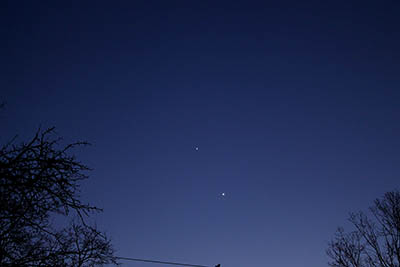
A pretty sight in the dusk, through late February into March 2023.
26 February 2023 at 23.12 UT. Jupiter (mag -2.1) is 3.3° above left of Venus (mag -3.9). Cloud prevailed in the succeeding days.Image taken with a Canon DSLR at 52 mm focal-length, with a 1 s exposure.

29 May 2022 at 08.10 UT. Bright Jupiter (mag -2.2) with Mars (mag +0.7) just 35' to its lower right. Both planets were a very pretty sight to the naked-eye.
Taken with a Canon DSLR at 55 mm focal-length. 4 s exposure.
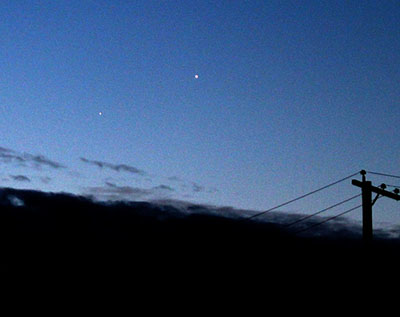


Left: 28 April. Bright Venus (mag -4.2) with Jupiter (mag -2.1) 2.3 ° away to the lower left. 09:15 UT.
Middle: 29 April. Lovely view of Venus (mag -4.1) with Jupiter (mag -2.1) to the left. Separation 1.4 °. 09:04 UT.
Right: 1 May. Striking close pair of Venus (mag -4.1) and Jupiter (mag -2.1). Jupiter has now moved to the upper right. Separation 31'. 08:51 UT.
All taken with a Canon DSLR at 55 mm focal-length.


Bright Jupiter (mag -2.0) with Saturn (mag +0.6) under its glare. 6.2' apart. Canon DSLR.
Left: 2.0 s exposure. 21st December 2020 at 22:19 UT. Focal length 55 mm.
Right: 70 mm refractor. 21st December 2020 at 22:09 UT. Focal length 480 mm.




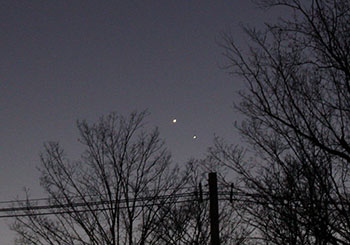

Bright Jupiter (mag -2.0) and Saturn (mag +0.6) are a striking sight to the naked-eye. Canon DSLR. Unless stated all focal lengths are 55 mm. Images left to right:

Bright Venus (mag -4.1) passes Regulus (mag 1.4). They were 0.5° apart and striking to the naked-eye. The Sickle of Leo is to the upper left of the pair.
Canon DSLR with a lens set at 40 mm focal length. 4 s exposure. Taken at 09:52 UT on 3rd October 2020.

Venus (mag -4.3) and Mercury (mag -0.6) were 1.6° apart. Venus is just above the trees, with Mercury to the left. Venus was 6° high.
DSLR lens 55 mm focal length. 0.6 s exposure. Cropped. Taken at 01:02 UT on 23rd May 2020.

Venus (mag -4.6) passed through the Pleiades open star cluster M45 and was still a striking sight on 2020 April 5 at 00:50 UT.
200 mm camera lens at ISO 800. Exposure 10 s with a DSLR (Canon 700D). Venus was then 0.9° E of the brightest Pleiad Alcyone.

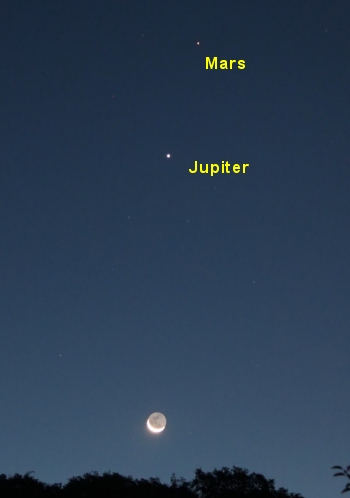

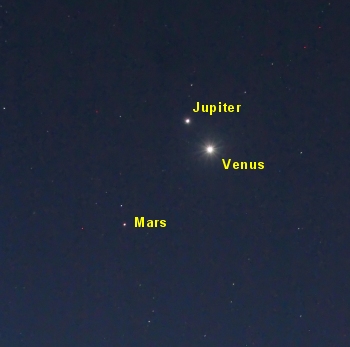
DSLR Camera at ISO 800. Focal length between 35 mm and 50 mm.


Both taken with a DSLR zoom lens set at 55 mm focal length, ISO 800.

Venus (mag -3.9) and Mercury (mag -0.8) only 43' apart. They were peering through the trees and power lines. Mercury is 5.9° high.
DSLR lens 200 mm focal length. 1/10 second exposure, ISO 400. Cropped. Taken at 22:12 UT.


Both taken with a DSLR zoom lens set at 55 mm focal length, at 1/8 second. In the foreground is Topsfield Town Hall, MA, USA.


Left: Ceres (mag 7.3) approaches Vesta (mag 6.1), 2.6° apart and closing. Also in Virgo is Mars (mag -1.2). DSLR zoom lens at 55 mm focal length. 10 second exposure. 25thMarch 2014 at 07:56 UT.
Right: Conjunction of asteroids Ceres and Vesta, only 11.7' apart. 2014 July 7. CCD camera on 106 mm refractor. 2014 July 7th at 01.44 UT.

Venus (mag -3.8) with Mercury (mag -0.6) 3° above. Below Venus Jupiter (mag -1.9), suffering high atmospheric extinction, is deep within the red twilight glow.
DSLR zoom lens at 100 mm focal length. 1/15 second exposures. Cropped. Taken on 29th May 2013 at 21:32 UT.

Uranus is almost a perfect match for 5.8 mag type G5 star 44 Piscium. They were separated by 1.3'.
106 mm f/5.0 refractor and CCD. 3x1 second exposures. South up and the Field of View is 45'x30'. Taken on 23th Sep 2012 at 01:16 UT.

Venus (mag -4.7) and Jupiter (mag -2.1) pass near the Hyades star cluster (at this stage with only the first magnitude star Aldebaran showing - the rest are lost in the dawn brightness). The waning crescent moon enhances the scene. 2012 July 15 at 08:39 UT.
DSLR Zoom Telephoto Lens at 100 mm focal length. Exposure 0.6 s at ISO 400.

Venus (mag -4.5) passes just south of the Pleiades open star cluster M45. 2012 April 3 at 00:55 UT.
106 mm refractor at f/5 at ISO 400. Exposure 15 s with a DSLR. The field is 2.4° x 1.6°. North is up.
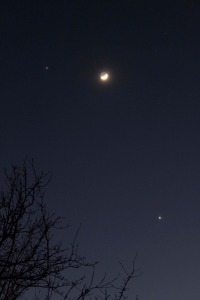
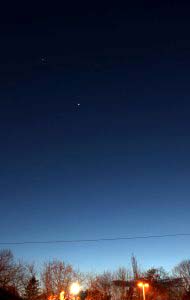
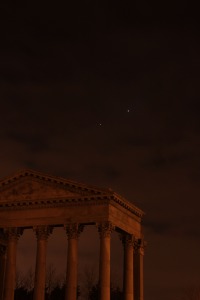

1: Venus approaching Jupiter, with the Moon (with earthshine) looking on, making a lovely sight. The planets are now separated by 15° and closing. The Moon is just 4° from Jupiter. Jupiter was magnitude -2.2 and Venus was -4.2.
Imaged with a DSLR Camera (55mm focal length) on the 26th February 2012 at 23.14 UT. 2 second exposure at ISO 800. Full frame. North Andover, MA.
2: The two bright planets (now 8.6° apart) are joined by Mercury.
Imaged with a DSLR Camera (27mm focal length) on the 4th March 2012 at 23.18 UT. 1.5 second exposure at ISO 800. Nearly full frame. Freeport, ME (the carpark of an Outlet!).
3: The two bright planets (3.0° apart) are at closest separation.
Imaged with a DSLR Camera (44 mm focal length) on the 13th March 2012 at 20.15 UT. 10 second exposure at ISO 800. Full frame. Partly cloudy, orange glow from sodium lights. Rush, Co Dublin.
4: Jupiter (at bottom) and Venus near the Hyades and the Pleiades.
Imaged with a DSLR Camera (23 mm focal length) on the 21th March 2012 at 20.44 UT. 39 second exposure at ISO 1600, not driven. Slightly cropped. From Villierstown, Co Waterford.
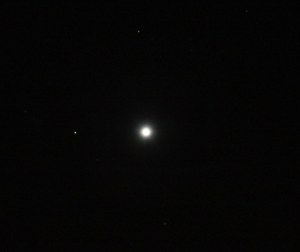
Uranus appears in the same telescopic field as Venus in Pisces. Uranus lies only 19' south-east of Venus. Venus (overexposed) is magnitude -4.1, while Uranus is magnitude 5.9. This translates to a 10,000 fold difference in brightness!.
Detail from 70 mm f/6.8 refractor and DSLR. 0.7 second exposure at ISO 3200. Undriven. Taken on 9thFebruary 2011 at 23:51 UT.
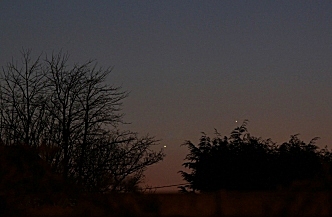
Mercury passed 2° north of Jupiter, low in the evening sky. Jupiter was magnitude -2.1 and Mercury was -1.0. Imaged with a DSLR Camera (133mm focal length) on the 15th March 2011 at 19.33 UT. 1 and 1/2 second exposure at ISO 400. Slightly cropped. Co Dublin.

Uranus appears in the same telescopic field as Jupiter. Uranus lies only about ½° north of Jupiter and its moons. Detail from 130 mm f/8 refractor and DSLR (Canon 500D). 8 second exposure at ISO 400. Light pollution filter used. Taken on 3rd January 2011 at 18:31 UT.
The key to the visible Galilean Moons of Jupiter is: II = Europa; III = Ganymede; IV = Callisto. Hip 117614 is a 7.9 magnitude star.

Venus as viewed from Topsfield, Ma, USA on Skype (via Sara). The altitude of Venus was 15.5 degrees in mid-twilight. 05.52 EST. Spica was just to the top right. Although the webcam lens did not pick up Spica, it was visible to the naked-eye.

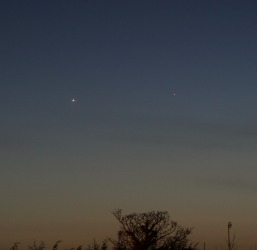

Venus and Mercury hang together in the western sky. Telephoto lens set at 133 mm focal length. 0.5 second exposure, ISO 200. Image cropped. From Co Dublin. 27th March 2010 at 19:39 UT. Venus was magnitude -3.9 and Mercury -1.2.
By April 7th they were much closer (3.3°). Telephoto lens set at 100 mm focal length. 1.5 second exposure, ISO 200. 20:15 UT. Image cropped. From Co Dublin. Venus was magnitude -3.9 and Mercury -0.1.
On April 16th the 'new' crescent Moon had joined the group. By then, Mercury had faded to magnitude 1.4. Image cropped. Telephoto lens set at 92 mm focal length. 2 second exposure, ISO 200. The atmosphere was hazy due to the dust from the Icelandic volcano near the Eyjafjallajökull glacier.
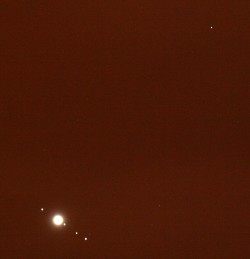
Neptune appears in the same telescopic field as Jupiter. Neptune lies only about ½° north of Jupiter and its moons. Detail from 130 mm f/8 refractor and DSLR. 3 second exposure at ISO 400. The orange glow is from a near-by sodium street light. Taken on 21st December 2009 at 17:55 UT.
The key to the four Galilean Moons of Jupiter is: I = Io; II = Europa; III = Ganymede; IV = Callisto.

The conjunction, Venus is near the moon. 60 mm f/5.9 refractor. 1.5 second exposure (not driven). From Loughshinny, Co Dublin. 1st December 2008 at 17:36 UT. Earlier that day, during the afternoon, the moon covered (or occulted) Venus.
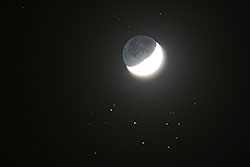
The Moon and the Pleiades. 70 mm f/6.8 refractor. 6 second exposure. 12th March 2008 at 20:09 UT.
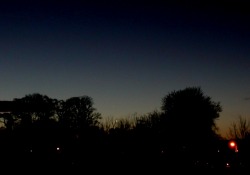
Mercury 1° above Venus, just above the trees. Venus was mag -3.9 and Mercury was -0.3. Imaged with a digital camera on the 30th December 2004 at 07.37 UT from Sandyford, Dublin. 1/2 second at ISO 100.
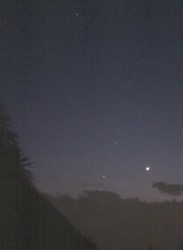
Taken on 5th May 2002 showing a Venus, Saturn and Mars (in order of brightness) forming a triangle. The star El Nath (Beta Tauri) is at top. From Dundrum, Dublin.
Taken with a 50 mm camera lens camera (detail). 1/2 second exposure on Ektachrome 400 slide film.
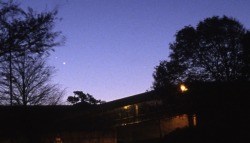
Taken on the morning of 2001 Oct 31. Fainter Mercury (mag. -0.7) is to the upper left of bright Venus (mag. -3.9), the two planets then were then only a little over a half a degree apart. From Dundrum, Dublin.
Shot with a 50 mm camera lens (detail). 1/2 second exposure on Fujichrome 200 slide film.

Venus and the Pleiades. 210 mm telephoto lens. Undriven. Fujichrome 400 slide film. 4th April 1988 at about 21h UT. Brilliant Venus (mag -4.5) was 1.5° from the cluster.

Taken at about 20 h on 1986 April 10. Bright Venus (mag. -3.9) is upper-left of the 1.6 day old Crescent Moon. The two objects were then 3° apart. From Parque Nacional del Teide, Tenerife, Canary Islands.
Shot with SLR and a 50 mm lens. 1/2 second exposure on Fujichrome 200 slide film.